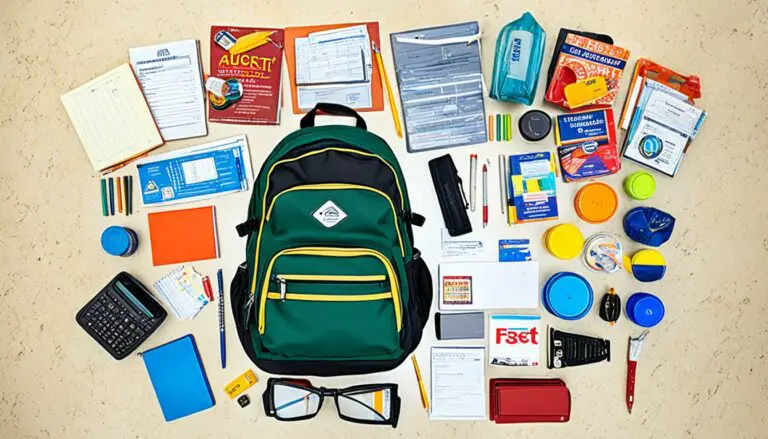Is the SAT Hard? A Clear and Knowledgeable Answer
Is the SAT Hard? Yes, the SAT can be tough due to time limits and question styles. The SAT is a standard test for college readiness. It has sections for Reading, Writing, and Math (with and without a calculator). It measures critical thinking and problem-solving skills. Students wonder about its difficulty and how to prepare.
Though known as tough, the SAT is conquerable. With prep, scores can rise, boosting college prospects—resources like practice tests, guides, and online courses aid preparation.
While the SAT challenges some, remember it’s just one college factor. Grades, activities, and personal traits also matter for admissions.
Understanding the SAT
Overview of the SAT
The SAT is used for college admissions in the US. It evaluates a student’s college readiness and reading, writing, and math proficiency. Administered by the College Board, it’s usually taken by 11th and 12th graders.
The SAT consists of four sections: Reading, Writing and Language, Math (calculator), and Math (no calculator). Each part is scored from 200 to 800, totaling 1600. An optional Essay section is scored separately from 2 to 8.
SAT vs ACT
The SAT and ACT are standardized tests used in college admissions, differing in format and content. The ACT comprises four sections: English, Math, Reading, and optional Science, with an additional Writing part. Conversely, the SAT lacks a Science section but includes a Writing and Language section.
The SAT focuses more on reasoning and critical thinking skills, while the ACT focuses more on content knowledge. Students should take both tests to determine which one they perform better on.
New SAT vs. Old SAT
In 2016, the College Board introduced a new version of the SAT. The new SAT focuses more on real-world problem-solving and analysis and includes more relevant and practical questions. The new SAT also has an optional Essay section, whereas the old SAT required the Essay section.
The updated SAT is graded on a range from 400 to 1600 points, with every section receiving a score between 200 and 800. The Essay section is graded independently on a scale of 2 to 8.
Format and Structure of the SAT
SAT Test Format
The SAT is a standardized exam assessing a student’s college preparedness. It comprises three core parts: Reading and Writing, Math, and an optional Essay. Students take the test in one go, which can be done on paper or digitally.
Time Limit and Structure
The SAT takes three hours to complete, plus an additional 50 minutes if the student chooses to take the Essay. The test is divided into multiple sections, each with a specified time limit. The table below shows the format and time limits for each section of the SAT:
🌟 Hey Students! 🚀 Ready for the ultimate experience? Join us on Studentsinside.com's Facebook, YouTube, WhatsApp, and LinkedIn. Click now for tips, fun, and success vibes! 🌈✨ #StudentLife #JoinUs
| Section | Time Limit |
|---|---|
| Reading | 65 minutes |
| Writing and Language | 35 minutes |
| Math (No Calculator) | 25 minutes |
| Math (Calculator) | 55 minutes |
| Essay (Optional) | 50 minutes |
Types of Questions
The SAT has different question types: multiple-choice, grid-in, and Essay. The Reading, Writing, and Language sections use multiple-choice questions.
The Math sections have both multiple-choice and grid-in questions. For the Essay section, students read a passage and write an analysis of the author’s argument.
In the Reading section, students are tested on their ability to comprehend and analyze a variety of written passages. The Writing and Language section tests students’ ability to revise and edit written passages.
In the Math sections, students are tested on their understanding of algebra, geometry, and trigonometry.
Sections of the SAT
The SAT consists of three primary parts: Reading, Math, and Writing. Each of these sections evaluates distinct skills and knowledge.
Reading Section
The SAT Reading section evaluates a student’s skill in understanding written passages. It includes 52 multiple-choice questions focused on five reading passages. These passages explore science, history, literature, and social studies.
To do well in the Reading section, students need to be able to identify the main idea of a passage, understand the author’s purpose, and analyze the structure of the text.
They should also be able to identify and interpret literary devices such as metaphors, similes, and symbolism.
Math Section
The SAT Math section consists of two parts: No Calculator and Calculator. It assesses students’ grasp of math concepts like algebra, geometry, and trigonometry.
The No Calculator section consists of 20 multiple-choice questions and five grid-in questions. The Calculator section consists of 38 multiple-choice questions and eight grid-in questions. Students are allowed to use a calculator for the Calculator section.
To do well in the Math section, students need to be able to solve problems using mathematical concepts and formulas. They should also be able to interpret data presented in graphs and tables.
Writing Section
The Writing section of the SAT students’ ability to write a clear and well-organized essay. The section consists of one essay prompt that asks students to analyze a given argument.
To do well in the Writing section, students need to be able to analyze an argument, identify logical fallacies, and develop a well-organized and persuasive essay. They should also be able to use proper grammar, punctuation, and sentence structure.
Preparing for the SAT
Getting ready for the SAT might seem overwhelming, but by using effective study methods and the appropriate tools, students can boost their confidence and be well-prepared for the exam. Here are valuable tips to help in SAT preparation:
SAT Prep Resources
Many SAT prep resources are available to students, including SAT prep books, online courses, and tutoring services. Choosing resources that fit the student’s learning style and budget is essential.
Two well-known books for SAT preparation are “The Official SAT Study Guide” by the College Board and “The Princeton Review SAT Premium 2023” by The Princeton Review.
Online courses like Khan Academy offer free SAT prep resources and personalized study plans. Tutoring services like Kaplan and Sylvan Learning provide one-on-one instruction and customized study plans.
Study Strategies
Effective study strategies can help students maximize their SAT scores. One approach is to create a study schedule and stick to it. This can help students stay organized and cover all the necessary material.
An additional approach involves concentrating on the areas where the student struggles the most. To identify these areas, the student can take practice tests and pinpoint their weaknesses.
After recognizing these weak points, students can center their study sessions around improving in those areas.
It is also important to use active studying techniques, such as taking notes and creating flashcards, to help retain information. Additionally, students should take breaks during their study sessions to avoid burnout and maintain focus.
Practice Tests
Engaging in practice tests is a crucial aspect of preparing for the SAT. These tests aid students in getting accustomed to the exam’s structure and pinpointing their weak points.
Official practice tests are available on the College Board’s website, and numerous SAT prep books also provide practice test resources.
It is recommended that students take multiple practice tests to track their progress and identify areas of weakness. Additionally, students should simulate test conditions when taking practice tests, including timing and taking the test in a quiet environment.
Challenges in the SAT
The SAT is a demanding exam where students must tackle diverse questions within a tight timeframe. Let’s explore several challenges they might encounter:
Time Pressure
One of the biggest challenges of the SAT is time pressure. Students have limited time to answer many questions, which can lead to stress and anxiety. For example, the SAT Reading section gives students 65 minutes to answer 52 questions, which means they have just over a minute to answer each question.
This can be incredibly challenging for students needing help with reading comprehension or getting used to taking timed tests.
Test Anxiety
Another challenge of the SAT is test anxiety. Many students experience stress and anxiety when taking standardized tests, which can affect their performance.
Test anxiety can cause students to second-guess themselves, make careless mistakes, or feel overwhelmed by the test. It can also make it difficult for students to concentrate and stay focused during the test.
High-Level Reading Passages
The SAT Reading section includes high-level passages that can be challenging for some students. These passages often require students to analyze complex ideas, draw inferences, and identify the author’s tone and purpose.
Students not used to reading at this level may find these passages challenging to understand, affecting their ability to answer the questions.
Scoring and Interpretation
Understanding SAT Scores
The SAT is graded using a range of 400-1600 points, split into two sections: Math and Evidence-Based Reading and Writing (EBRW), each with a score range of 200-800.
Your overall score is the combination of these section scores. This scoring method ensures fairness and allows for meaningful score comparisons among test-takers across dates.
Guessing Penalty
The SAT has a guessing penalty, meaning test-takers are penalized for incorrect answers. A quarter-point is deducted from the raw score for each wrong answer.
However, no points are deducted for unanswered questions. This means that test-takers should only guess on questions they are reasonably confident about, as random guessing is likely to result in a lower score.
SAT Rankings
SAT scores are commonly employed to gauge academic achievement and carry weight in college applications. Nevertheless, it’s crucial to remember that they constitute just a portion of the admission process. Admission committees also evaluate other elements like GPA, extracurriculars, and essays.
In addition, SAT scores are also used for other purposes, such as scholarship awards and academic research. For example, some colleges and universities offer merit-based scholarships to students with high SAT scores.
The SAT and College Admissions
The SAT is among the most critical factors colleges consider for college admissions.
College Board
The College Board is the organization that administers the SAT. They are responsible for creating and grading the test and providing colleges with each student’s scores.
The College Board also offers a range of resources to help students prepare for the SAT, including practice tests, study guides, and online courses.
Scholarships
Many colleges and universities provide scholarships for high-scoring SAT students. These scholarships aid college funding and highlight a student’s academic promise.
However, it’s important to note that scholarships are not solely based on SAT scores. Other factors, such as GPA, extracurricular activities, and community service, also play a role in determining scholarship eligibility.
GPA and SAT Scores
Although the SAT holds significance in college admissions, it’s just one piece of the puzzle. Colleges also evaluate students based on their GPA, extracurricular engagements, and community involvement.
They aim to admit individuals who excel academically, participate actively in various activities, and show dedication to their community.
It’s also important to note that different colleges have different admissions requirements. Some colleges place more emphasis on SAT scores, while others place more emphasis on GPA and extracurricular activities.
Researching the admissions requirements of the colleges you’re interested in is essential to determine the most critical factors.
Comparing the SAT with Other Tests
SAT vs GRE
The GRE is a standardized test for getting into graduate school. It’s like the SAT but harder. Both tests cover reading, vocabulary, and math, but the GRE is tougher. The GRE also has writing and thinking sections that could improve the SAT.
| Test | SAT | GRE |
|---|---|---|
| Purpose | College admissions | Graduate school admissions |
| Sections | Reading, Writing, Math | Verbal Reasoning, Quantitative Reasoning, Analytical Writing |
| Scoring | 400-1600 | 130-170 (per section) |
| Time | 3 hours | 3 hours 45 minutes |
SAT vs GMAT
The GMAT is a standardized test used for business school admissions. It assesses skills like reading comprehension and math, similar to the SAT, but is generally seen as more challenging. Additionally, the GMAT has sections on integrated reasoning and analytical writing, which could enhance the SAT.
| Test | SAT | GMAT |
|---|---|---|
| Purpose | College admissions | Business school admissions |
| Sections | Reading, Writing, Math | Integrated Reasoning, Analytical Writing, Verbal Reasoning, Quantitative Reasoning |
| Scoring | 400-1600 | 200-800 (per section) |
| Time | 3 hours | 3 hours 30 minutes |
SAT vs LSAT
The LSAT is a standardized law school entry exam assessing logical and analytical reasoning skills. In contrast to the SAT, it places a greater emphasis on critical thinking abilities. It’s worth noting that the LSAT presents a higher difficulty level than the SAT.
| Test | SAT | LSAT |
|---|---|---|
| Purpose | College admissions | Law school admissions |
| Sections | Reading, Writing, Math | Logical Reasoning, Analytical Reasoning, Reading Comprehension |
| Scoring | 400-1600 | 120-180 |
| Time | 3 hours | 2 hours 55 minutes |
Conclusion
In conclusion, the SAT is widely considered to be a challenging exam. However, it is a manageable task with proper preparation and understanding of the test format. The SAT covers concepts typically taught in the first two high school years, sprinkling a few more advanced concepts.
The difficulty level of the SAT can vary from test to test, as evidenced by the average rating of the August 2022 SAT. However, it is essential to note that the SAT is designed to be challenging to assess a student’s academic abilities accurately.
Students can use multiple tools to prepare for the SAT exam, such as study books, mock tests, and tutoring assistance.
Developing effective test-taking strategies, such as time management and process of elimination, can also help improve scores. While the SAT may be difficult, it is not an impossible task.








